There’s a kind of quiet beauty in a rustic living room — that feeling of stepping into a space that just feels right. It’s not about everything being perfectly coordinated or brand new. It’s about textures that tell a story, colors that wrap around you like a blanket, and furniture that looks like it’s been part of your life forever.
Rustic style isn’t just a “look” — it’s an attitude toward comfort. It embraces imperfections, celebrates age, and leans into warmth. It’s cozy, humble, and utterly timeless.
You don’t need a cabin in the woods or a farmhouse miles from town to capture it. The rustic look works beautifully in city apartments, modern homes, or anywhere you want a little natural soul.
So here are 7 warm rustic living room ideas that’ll help you bring that grounded, lived-in feeling into your own space — no matter where you are.
1. Go All In With Natural Materials
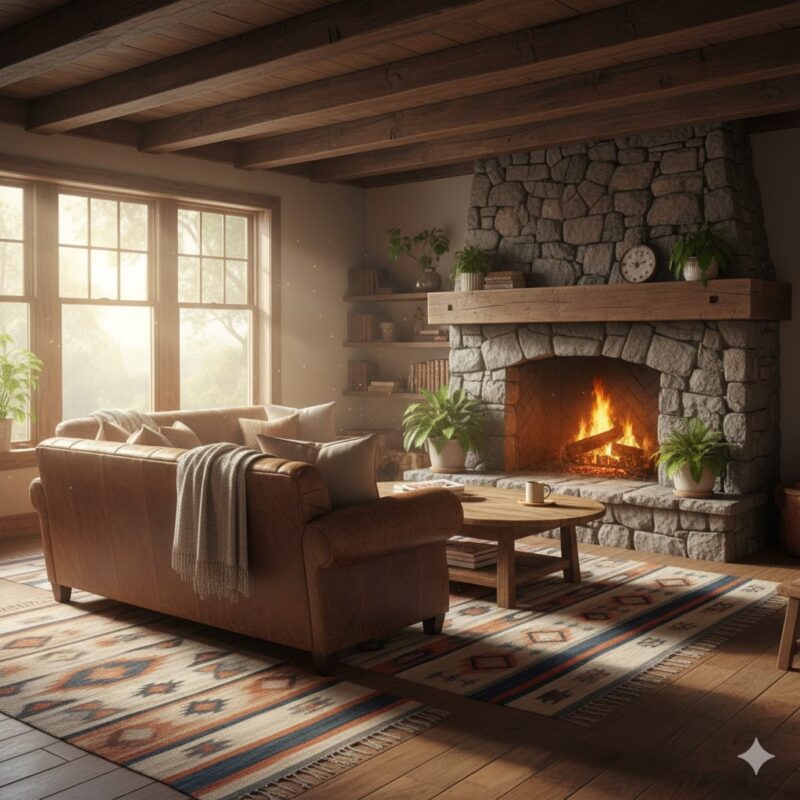
If there’s one rule to rustic design, it’s this: nature comes first.
Wood, stone, linen, leather — those are your heroes here. The more authentic the texture, the richer the atmosphere.
Start with what you already have. If you’ve got hardwood floors, show them off. If you’re renovating, consider reclaimed wood beams or a natural stone accent wall. Even a few smaller touches — like a driftwood coffee table or a woven jute rug — can shift the whole mood.
Leather sofas, especially in worn tan or deep brown, add warmth and depth. Linen or cotton cushions soften the edges. And don’t forget metal — a touch of iron in a lamp base or a vintage tray brings just enough contrast to keep the look interesting.
Rustic isn’t about perfection; it’s about connection. Every texture should feel like it belongs.
2. Keep Your Color Palette Earthy and Honest
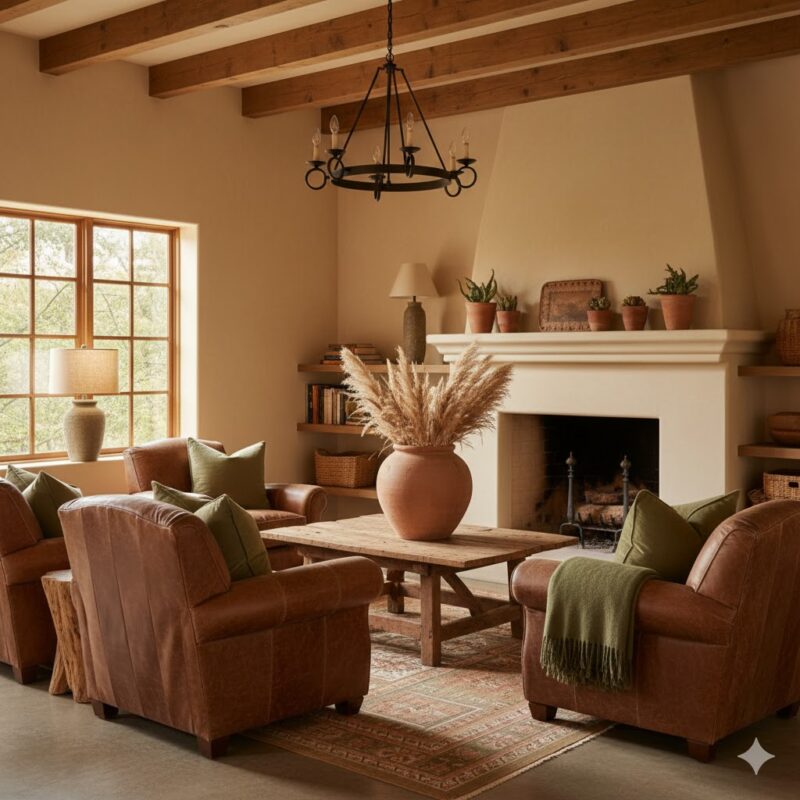
Rustic color palettes draw straight from the landscape. You’ll rarely see anything neon or glossy — instead, it’s soft earth tones and sun-faded hues.
Think clay, cream, olive, charcoal, and muted wood browns. Those colors create the foundation of warmth that rustic rooms are famous for.
You might paint the walls a soft mushroom beige, then layer in darker wood tones through furniture. Add sage green cushions or terracotta pottery to break the monotony just enough.
There’s something peaceful about these tones. They don’t demand attention — they invite it.
The palette feels grounded and old-world, as though it’s been there for generations.
3. Embrace Imperfection (It’s the Soul of Rustic Style)
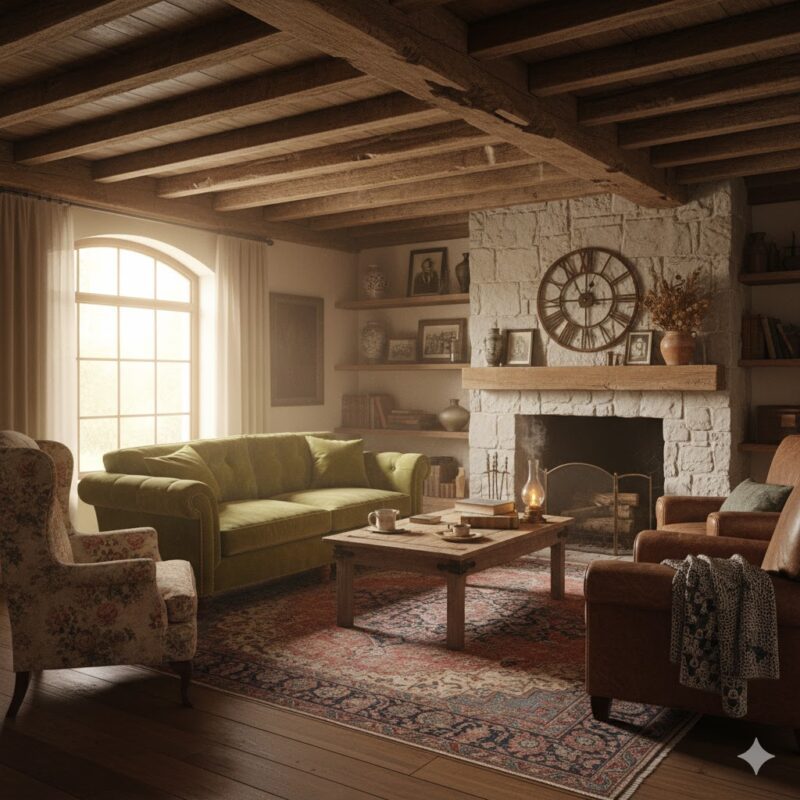
Here’s the funny thing: in a rustic space, the scratches, dents, and faded patches aren’t flaws — they’re personality.
Modern homes often chase clean lines and slick finishes, but rustic spaces thrive on texture and irregularity. That old wooden chest with a crack down the side? Keep it. It’s got more soul than a brand-new table ever will.
Even your decor doesn’t need to be matchy-matchy. Combine furniture from different eras. Mix woods — a dark walnut table beside a pale pine cabinet can look surprisingly harmonious if the shapes complement each other.
The point is: real life leaves marks. Rustic interiors don’t hide them — they celebrate them.
4. Layer Your Lighting for Warmth
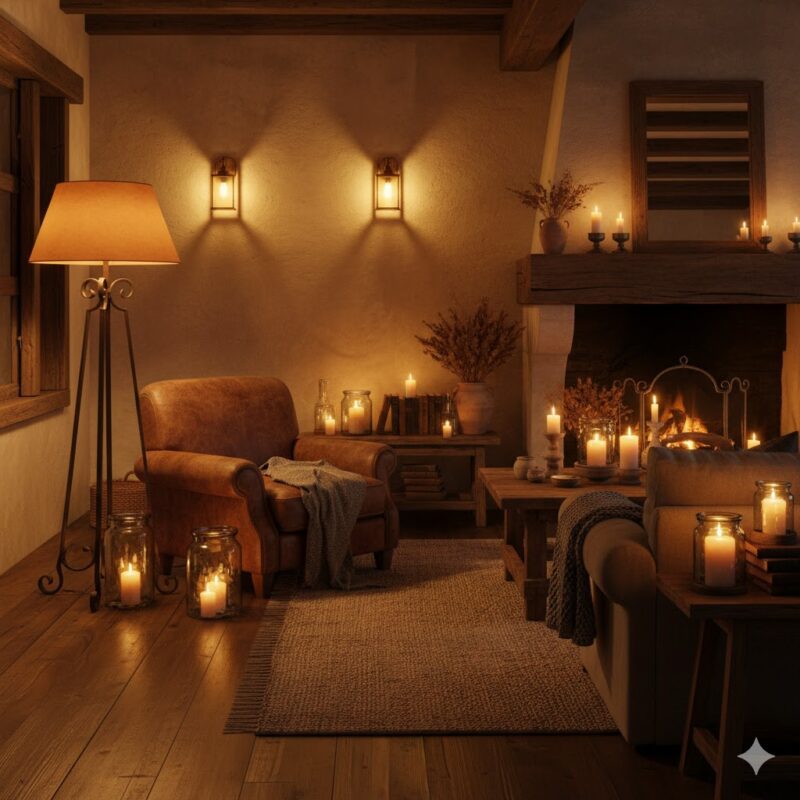
Lighting can make or break the rustic feel. Harsh overhead lights can flatten everything, but soft, layered lighting gives your space that golden evening warmth.
Mix it up — a woven rattan pendant overhead, a couple of metal or ceramic table lamps, maybe even wall sconces with amber bulbs. Each light adds a little pocket of coziness.
Candles, of course, are a must. Scatter a few around the mantel or coffee table, and you’ll instantly feel that quiet calm that makes rustic interiors so magnetic.
The goal isn’t brightness — it’s glow. You want that soft flicker that makes the whole room feel alive after sunset.
5. Bring in Nature — Literally
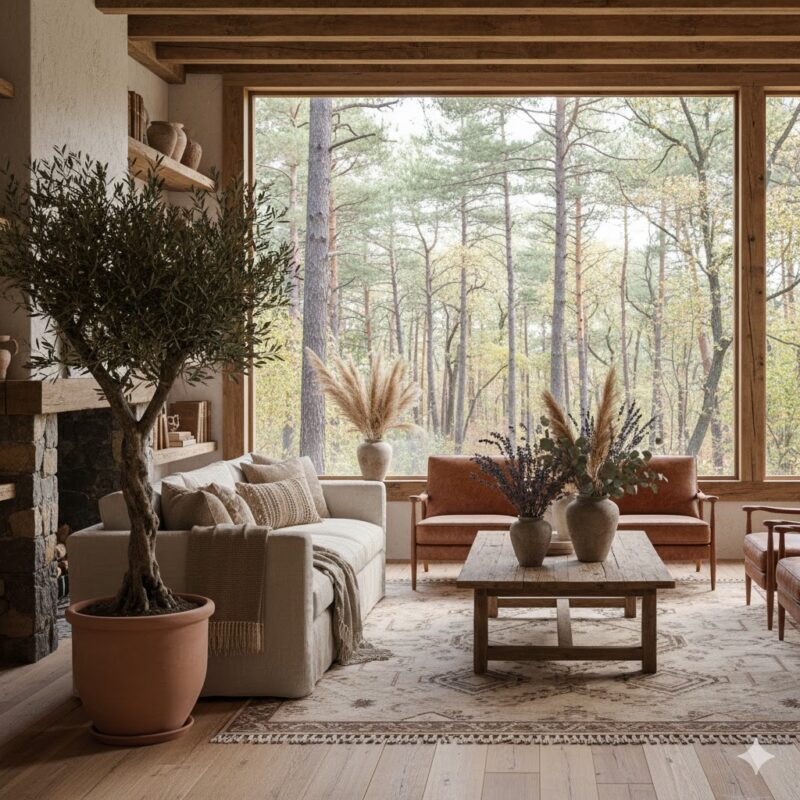
You can’t have a rustic space without a touch of the outdoors. It’s what keeps everything feeling organic and balanced.
Bring in greenery — potted plants, trailing vines, or even branches in a vase. Olive trees and rubber plants fit perfectly if you want low-maintenance greenery with substance.
If you prefer dried arrangements, try pampas grass, eucalyptus, or wheat stems. They add texture without feeling too polished.
It’s about that quiet link between inside and out. When you’re sitting in your living room and it feels like the outdoors is somehow part of it — that’s when you’ve nailed it.
6. Add Layers of Cozy Textiles
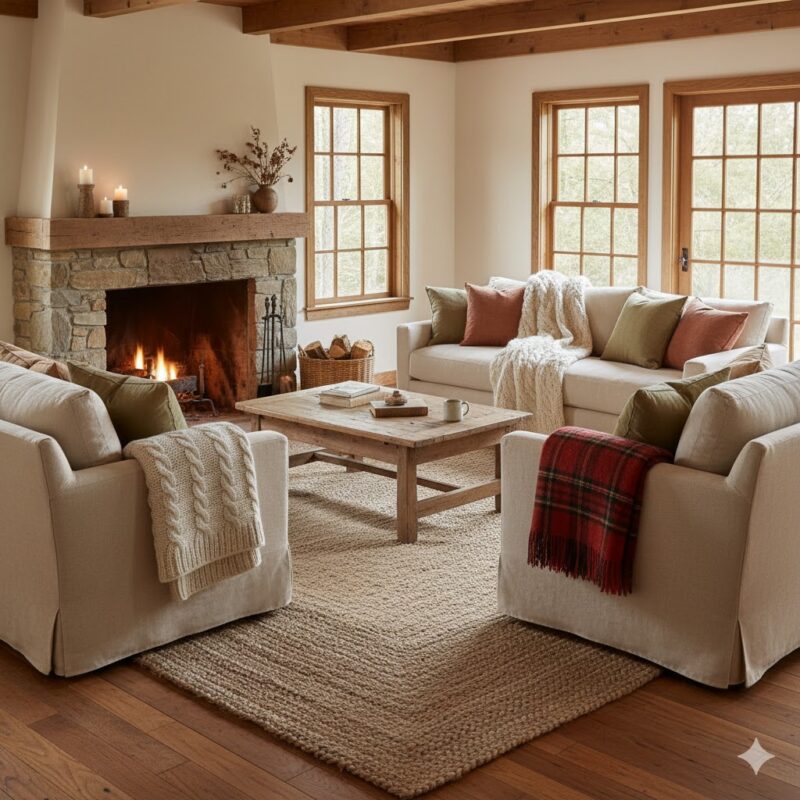
Texture is what makes a rustic living room feel like a hug.
Pile on blankets, rugs, and cushions in natural fabrics — wool, cotton, linen. Go for neutral tones, but mix textures: smooth, nubby, knitted, fringed. The layering makes everything feel rich and tactile.
If your sofa is plain, use throws and pillows to bring it to life. If your rug feels flat, add a smaller patterned one on top.
And don’t be afraid of pattern entirely — a simple plaid or faded kilim rug adds history and color without breaking the earthy theme.
The point is to make the room feel lived in — a space where you can curl up, read a book, or just nap on a rainy afternoon without worrying about messing things up.
7. Add Personal, Timeworn Details
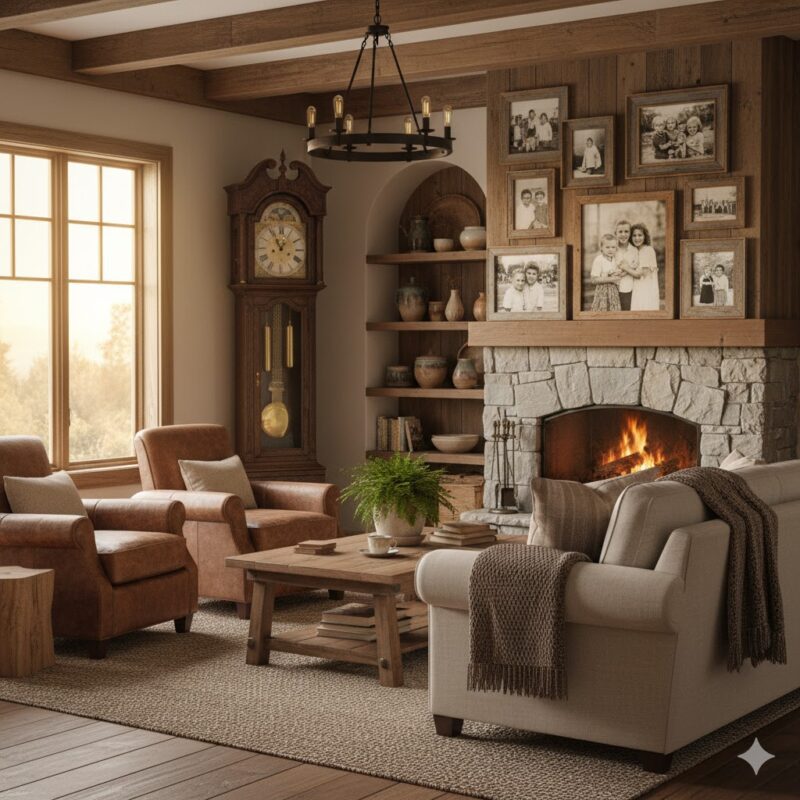
Rustic design isn’t about buying everything from one catalog — it’s about layering memories.
That old clock from your grandparents, a woven basket from a market trip, a ceramic bowl you made years ago — these are the pieces that make a space feel alive.
Group them together naturally, not like a showroom display. Maybe some books stacked unevenly, a candle melted halfway down, a slightly crooked frame.
There’s beauty in imperfection, and that lived-in feeling is what separates rustic spaces from sterile ones.
Your home should look like it’s been lived in, not styled for a photo. And that’s what gives rustic living rooms their warmth — the sense that life happens here, every single day.
The Heart of Rustic Warmth
If there’s one takeaway, it’s that rustic living rooms are less about design rules and more about feeling.
They tell quiet stories through the creak of floorboards, the worn edges of a coffee table, the smell of wood and candle wax in the air.
It’s a place where comfort wins over perfection — where you can put your feet up, sip tea by the fire, and not worry about a thing being out of place.
Warm rustic style works because it’s deeply human. It feels like home, even if you’ve just walked in.
And honestly, in a world that’s constantly chasing the next new thing, maybe that sense of permanence — that gentle, earthy calm — is exactly what we all need a bit more of.
Before you go…. Your home decor is a significant financial investment—don’t let an accident, like spills or moving mishaps, ruin your aesthetic peace! Protecting those high-value decor items (especially custom pieces!) requires more than basic coverage; you need a solid home contents insurance policy or specific personal property riders. Finding the best homeowners insurance or renters insurance that covers your unique decor is key to keeping your space beautiful and your wallet safe.
For truly high-value or custom furnishings, specialist companies like Chubb offer comprehensive policies, though their average annual cost may be upward of $9,500 for high-value homes. For standard policies, the national homeowner average is around $2,100 per year, but this varies. Thankfully, renters insurance is much more affordable, often costing just $150 to $300 per year. The key is “scheduled personal property” coverage for your valuables; this can cost as little as $50 to $200 annually per $10,000 in value for art and antiques. National carriers like State Farm, GEICO, Allstate, and Progressive are great starting points for comparison.
Getting a quote is simple and super fast now, so you have no excuse not to check your coverage today.